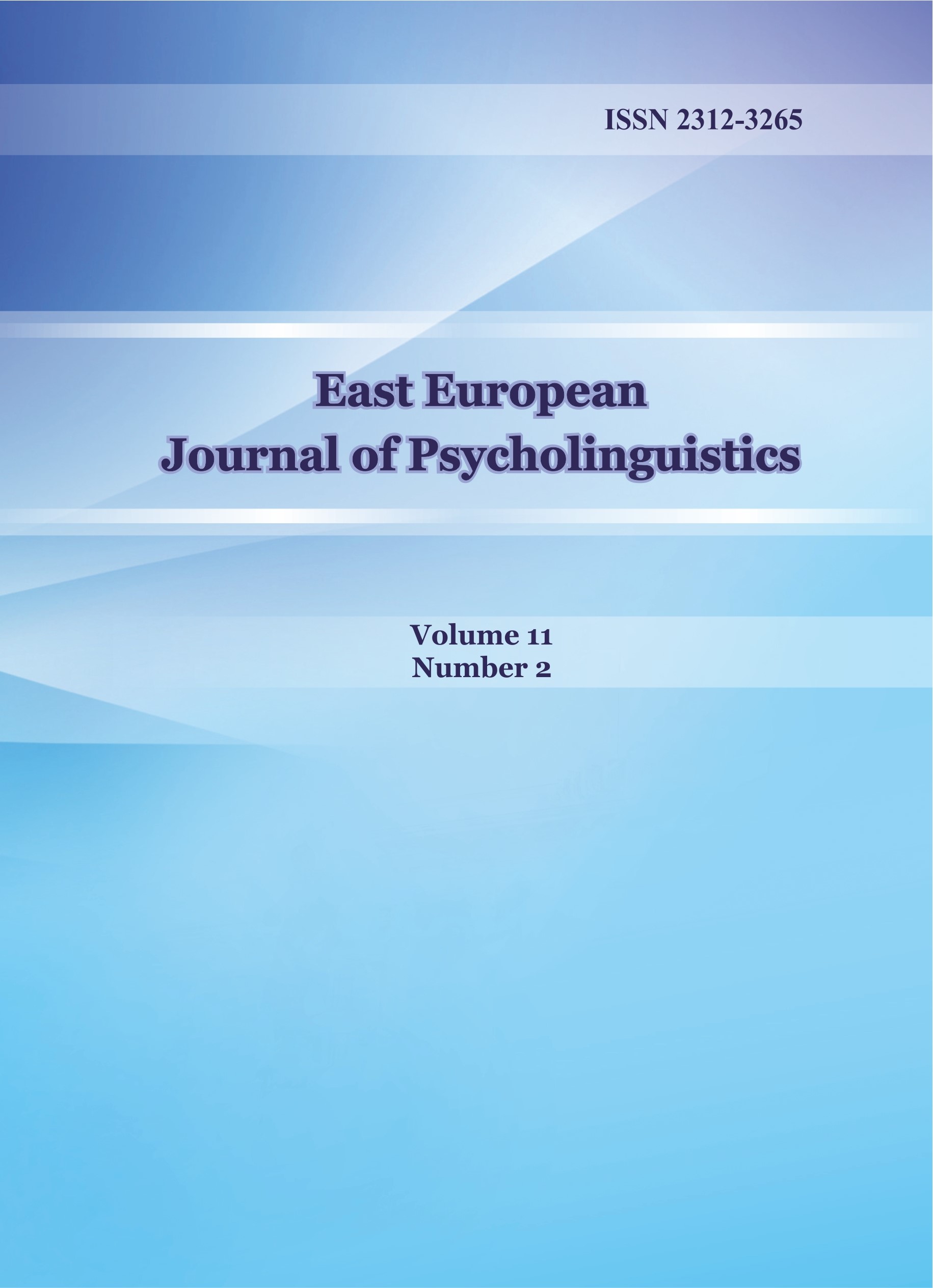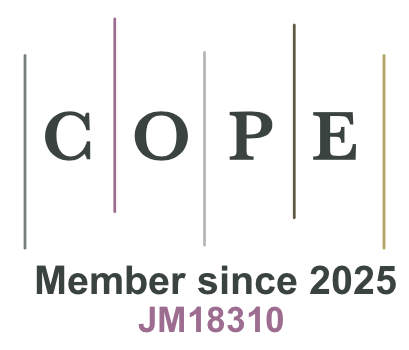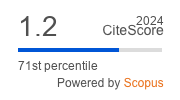Prosodic realization of Focus in the Albanian language
DOI:
https://doi.org/10.29038/eejpl.2024.11.2.jakКлючові слова:
focus, stress, align-XP, stress-focus, match Albania-Serbia (2014) , broadcast PressingАнотація
Prosodic tools have been treated as main elements for focus marking in different languages. Among them, stress is assumed to have a key role in the realization of focus. Researchers such as Selkirk (1995) assume that focus realization occurs when stress interacts with syntactic and phonological components. However, researchers such as Truckenbrodt (1999), Samek-Lodovici (2005; 2006), Féry (2013; 2016), Lee (2013), Yan et al. (2022) disagree with his hypothesis as, according to them, focus is realized through interactions between prosodic structure, syntactic structure, stress, and information structure. According to the latter, this realization of focus can be explained through three constraints: align XP, wrap XP, and stress-focus, which arose from Optimality Theory. Therefore, in order to investigate the prosodic realization of focus in the Albanian language, we will rely on these notions of limitations to see the interactions of different linguistic domains in the realization of informative and emphatic focus through emphasis in our corpus, which consists of: match commentary Albania vs Serbia (2014) and the broadcast Pressing (May 30, 2022). The method used in this work is based on the analysis of the Optimality Theory of sentence stress which integrates insights from the generative linguistics, through which interactions between focus prominence and phrases are highlighted. The results provide evidence that the interactions of these syntactic and prosodic constraints influence the Albanian speaker to realize the focus in different positions within the sentence.
Завантажити
Посилання
Büring, D. (2010). Towards a typology of focus realization. In M. Zimmermann & C. Féry (Eds.), Information structure. Theoretical, typological, and experimental perspectives. Online Edition. (pp. 177–205). Oxford Academic. https://doi.org/10.1093/acprof:oso/ 9780199570959.003.0008 DOI: https://doi.org/10.1093/acprof:oso/9780199570959.003.0008
Büring, D. (2016). Focus, questions and givenness. Questions in Discourse. Leiden: Brill.
Chafe, W. L. (1976), Givenness, contrastiveness, definiteness, subjects,topics and point of view. In Ch. N. Li (Ed.), Subject and Topic. (pp. 27-55). Academic Press,
Enderby, J. L., Carroll, J. M., Tarczynski-Bowles, M. L., & Breadmore, H. L. (2021). The roles of morphology, phonology, and prosody in reading and spelling multisyllabic words. Applied Psycholinguistics, 42(4), 865-885. http://dx.doi.org/10.1017/ S0142716421000096 DOI: https://doi.org/10.1017/S0142716421000096
Erteschik-Shir, N. (2007). Information structure: The syntax-discourse interface. Oxford: Oxford University Press. DOI: https://doi.org/10.1093/oso/9780199262588.001.0001
Féry, C. (2010). German intonational patterns (Vol. 285). Walter de Gruyter.
Féry, C. (2013). Focus as prosodic alignment. Natural Language & Linguistic Theory, 31(3), 683-734. https://doi.org/10.1007/s11049-013-9195-7 DOI: https://doi.org/10.1007/s11049-013-9195-7
Féry, C., & Ishihara, S. (Eds.). (2016). The Oxford handbook of information structure. Oxford University Press. DOI: https://doi.org/10.1093/oxfordhb/9780199642670.001.0001
Frascarelli, M., & Hinterholzl, R. (2007). Types of topics in German and Italian. In K. Schwabe & S. Winkler (Eds.), On information structure, meaning and form (pp. 87-116). John Benjamins. https://doi.org/10.1075/la.100.07fra DOI: https://doi.org/10.1075/la.100.07fra
Heinz, M. & Moroni, M. (2018). Prosody: Information Structure, Grammar, Interaction. Linguistik Online, 88(1). https://doi.org/10. 13092/lo.88.4187 DOI: https://doi.org/10.13092/lo.88.4187
Ge, H., Mulders, I., Kang, X., Chen, A., & Yip, V. (2021). Processing focus in native and non-native speakers of English: An eye-tracking study in the visual world paradigm. Applied Psycholinguistics, 42(4), 1057-1088. https://doi.org/10.1017/S0142716421000230 DOI: https://doi.org/10.1017/S0142716421000230
Kiliańska-Przybyło, G. (2023). Strategies employed for information transfer and relation building in intercultural communication–A cross-cultural study. East European Journal of Psycholinguistics, 10(1), 81-95. https://doi.org/10.29038/eejpl.2023.10.1.kil DOI: https://doi.org/10.29038/eejpl.2023.10.1.kil
Kügler, F., & Calhoun, S. (2020). Prosodic encoding of information structure: A typological perspective. In C. Gussenhhoven, & A. Chen (Eds.), The Oxford Handbook of Language Prosody. Online edn. Oxford Handbooks. https://doi.org/10.1093/oxfordhb/ 9780198832232.013.30 DOI: https://doi.org/10.1093/oxfordhb/9780198832232.013.30
Ladd, D. R. (2008). Intonational phonology. Cambridge University Press. DOI: https://doi.org/10.1017/CBO9780511808814
Lambrecht, K. (1994). Information structure and sentence form. Topic, focus, and the representation of mental referents in discourse. Cambridge University Press. DOI: https://doi.org/10.1017/CBO9780511620607
Lee, K. (2013). Sentence stress in information structure. 언어학 Oenoehak – Journal of Korean Linguistics Society, 66, 3-30.
Lindfield, K. C., Wingfield, A., & Goodglass, H. (1999). The contribution of prosody to spoken word recognition. Applied Psycholinguistics, 20(3), 395-405. https://doi.org/10. 1017/S0142716499003045 DOI: https://doi.org/10.1017/S0142716499003045
Rugova, B. (2006 dhe 2007) Gjuha e sportit. Filologji, 14/15, Universiteti i Prishtinës, Prishtinë, 141-156.
Rugova B. (2009). Gjuha e gazetave. Koha. Prishtinë.
Rugova, B, Sejdiu-Rugova, L. (2015). Hyrje në gramatikën e tekstit të gjuhës shqipe. Trembelat. Prishtinë.
Rugova, B. (2016). Riçke rome, itaçi e zakucati. Trembelat. Prishtinë.
Rugova, B. (2019). Leksikon i termave të fonetikës dhe të fonologjisë. AShAK. Prishtinë.
Samek-Lodovici, V. (2005). Prosody-syntax interaction in the expression of focus. Natural Language and Linguistic Theory, 23, 687-755. https://doi.org/10.1007/s11049-004-2874-7 DOI: https://doi.org/10.1007/s11049-004-2874-7
Samek-Lodovici, V. (2006). When right dislocation meets the left-periphery: A unified analysis of Italian non-final focus. Lingua, 116(6), 836-873. http://dx.doi.org/10.1016/j. lingua.2005.04.001 DOI: https://doi.org/10.1016/j.lingua.2005.04.001
Selkirk, E. (1986). On derived domains in sentence phonology. Phonology, 3, 371-405. DOI: https://doi.org/10.1017/S0952675700000695
Selkirk, E. (1995). Sentence prosody: intonation, stress, and phrasing. In John A. Goldsmith (ed.), The handbook of Phonological Theory. (pp. 550–569). Blackwell.
Selkirk, E. (2002). Contrastive focus vs. presentational focus: Prosodic evidence from right node raising in English. In B. Bel & I. Marlien (Eds.), Speech Prosody 2002: Proceedings of the 1st international conference on speech prosody. Aix-en-Provence, France. (643–646). DOI: https://doi.org/10.21437/SpeechProsody.2002-146
Truckenbrodt, H. (1995). Phonological phrases--their relation to syntax, focus, and prominance. Unpublished PhD dissertation. Massachusetts Institute of Technology.
Truckenbrodt, H. (1999). On the relation between syntactic phrases and phonological phrases. Linguistic Inquiry, 30(2), 219-255. DOI: https://doi.org/10.1162/002438999554048
Tsoukala, A., Vogelzang, M., & Tsimpli, I. M. (2024). Individual differences in L1 and L2 anaphora resolution: effects of implicit prosodic cues and working memory. Applied Psycholinguistics, 45(5), 834-872. https://doi.org/10.1017/S0142716424000316 DOI: https://doi.org/10.1017/S0142716424000316
Vallduví, E.. & Maria V. (1998). On rheme and kontrast. In P. Culicover & L. McNally (Eds.), The Limits of Syntax. Syntax and Semantics 29, (pp. 161-184). Academic Press. https://doi.org/10.1163/9789004373167_005 DOI: https://doi.org/10.1163/9789004373167_005
Yan, M., Warren, P., & Calhoun, S. (2022). Focus interpretation in L1 and L2: The role of prosodic prominence and clefting. Applied Psycholinguistics, 43(6), 1275-1303. https://doi.org/10.1017/S0142716422000376 DOI: https://doi.org/10.1017/S0142716422000376
Завантаження
Опубліковано
Номер
Розділ
Ліцензія
Авторське право (c) 2024 Qëndresa Jakupi

Ця робота ліцензується відповідно до ліцензії Creative Commons Attribution 4.0 International License.








 Creative Commons «Attribution» 4.0
Creative Commons «Attribution» 4.0